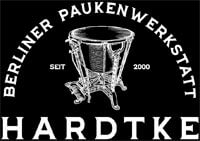Hardtke Timpani – FAQ
What kind of heads do you recommend for the Hardtke timpani?
We always recommend Irish Super Kalfo heads and Remo renaissance heads.
What is the playing height of the timpani without wheels?
The playing height without wheels is 81,5cm
Do you offer different kinds of wheels / Castors?
Yes, we offer the low wheels as you can see in the pictures. These wheels increase the height by 7 cm and the big wheels by 12 cm.
Do you offer a retractable wheel system?
Yes, we offer a system which allows the timpani to stand directly on the floor.
Can I order my own bowl design?
As you can see, we offer two different bowl shapes and thicknesses. If you have a special wish to shape or thickness, we can make it.
Can I have painted counter hoops instead of chrome?
Yes, we can paint them in the same colour as the frame
Can I order a special frame colour?
The standard colours are red/brown as on the site and Ivory, but we can do whatever you want – even pink.
Can I design my own flight cases?
Yes, the cases are always custom-made for specific orders. You can see the standard model on the site.
What is the difference between the Berlin and Dresden timpani?
The main differences between the Berlin and Dresden timpani lie in their construction and tonal characteristics. These differences are a result of the distinct developmental paths of these two types of timpani and are historically rooted. Here are the main distinctions:
1. Construction:
Berlin Timpani: Berlin timpani, also known as the “Berlin system,” have a cylindrical shape and are typically tuned using a mechanical tuning mechanism. These timpani are often somewhat more compact and lighter than Dresden timpani.
Dresden Timpani: Dresden timpani, referred to as the “Dresden system,” have a flat, kettle-shaped construction and are usually tuned using a pedal system. This allows for more precise and fine-tuning of the timpani.
2. Tone:
Berlin Timpani: Berlin timpani tend to have a brighter and more brilliant tone. This makes them well-suited for musical styles where clear articulation and projection are required, such as in orchestral music.
Dresden Timpani: Dresden timpani have a warmer and fuller tone. Their tonal character is particularly well-suited for the performance of Baroque music and historically informed performances.
3. Tuning:
Berlin Timpani: Berlin timpani are typically tuned in fifths or fourths, with the tuning mechanism allowing for precise adjustments.
Dresden Timpani: Dresden timpani are often tuned chromatically, meaning they can be tuned in half steps. This is especially important for the performance of Baroque-era works.
It’s important to note that the choice between Berlin and Dresden timpani largely depends on the musical requirements and preferences. Modern timpanists and orchestras may use both types of timpani as needed in their performances.
